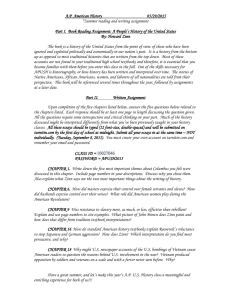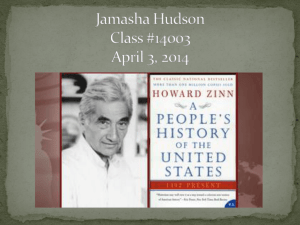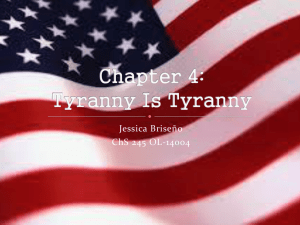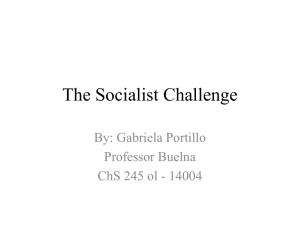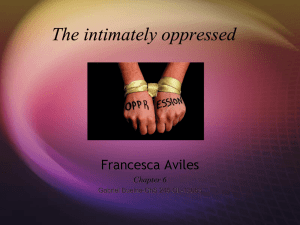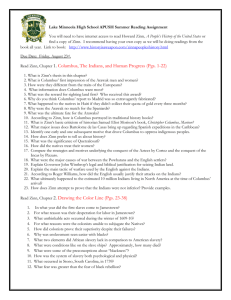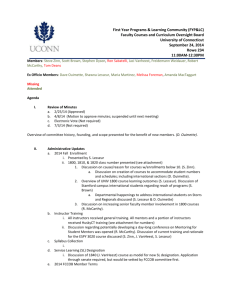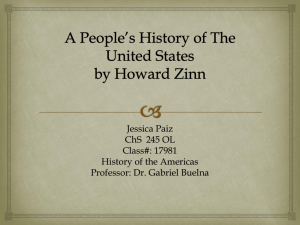Chapter 4: Tyranny is Tyranny
advertisement
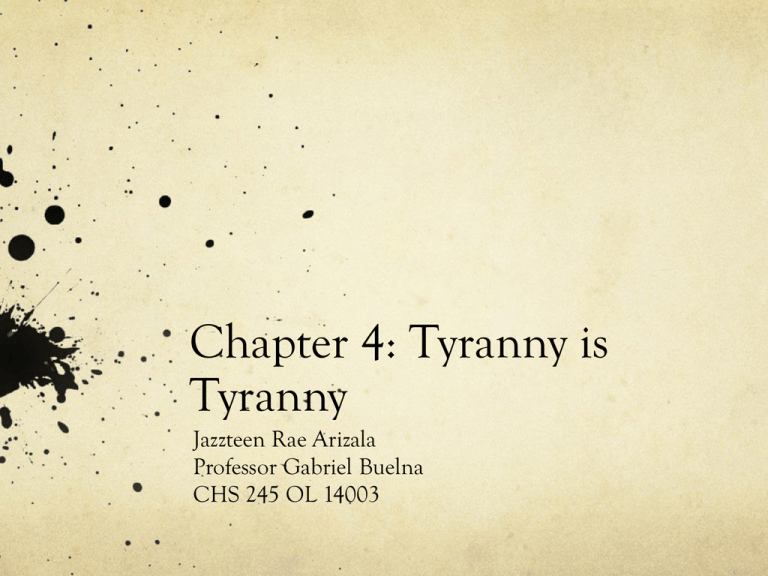
Chapter 4: Tyranny is Tyranny Jazzteen Rae Arizala Professor Gabriel Buelna CHS 245 OL 14003 Introduction “Tyranny is Tyranny let it come from whom it may” (Zinn, 75). British Empire vs. Colonial Elite Chapter 4 of Howard Zinn’s A People’s History of the United States, titled “Tyranny is Tyranny,” discusses the aftermath of the French and Indian War and America’s struggle for independence. As American leadership was less in need of British rule, the English were more in need of colonial revenue; “they found that by creating a nation, a symbol, a legal unity called the United States, they could take over land profits, and political power from favorites of the British Empire” (Zinn, 59). However, class hatred would undermine any power American leadership would choose to hold over colonies. Bacon’s Rebellion • • Since Bacon’s Rebellion in Virginia there were eighteen uprisings whose goal was to overthrow the government. American leadership saw this as an opportunity to steer insurgent energy against the British Empire. The Boston Caucus, lawyers, editors, and merchants excluded from the colonial elite, “molded laboring-class opinion, called the ‘mob’ into action, and shaped its behavior” (Zinn, 60). The upper class easily mobilized lower class energy for their own purposes through empathetic oratory and writing. Stamp Act of 1765 Stamp Act of 1765 The accumulated sense of grievance towards the rich may have accounted for the riots that followed the Stamp Act of 1765. The Stamp Act allowed the British to tax the American colony to pay for the expenditures of the French War. Colonists began targeting the homes of fifteen pro-British elite and destroyed them as part of “a War of Plunder, of general levelling and taking away the Distinction of rich and poor” (Zinn, 61). Through these riots, the poor colonists made clear what their motive was after the French War. “Is it equitable that 99, rather 999, should suffer for the Extravagance or Grandeur of one, especially when it is considered that men frequently owe their Wealth to the impoverishment of their neighbors?” (Zinn, 62). 1776 Elections in Pennsylvania The lower middle class, especially mechanics, pushed for open-air meetings in which the general population could participate in making policy, as well as elect more mechanics and other ordinary people into government positions. During elections for the 1776 convention, a Privates Committee wrote a bill of rights, including the statement that “an enormous proportion of property vested in a few individuals is dangerous to the rights, and destructive of the common happiness, of mankind; and therefore every free state hath a right by its laws to discourage the possession of such property” (Zinn, 62). The Privates Committee urged voters to oppose “great and overgrown rich men” (Zinn, 62). Regulator Movement During the period between 1766 and 1771, the years during which agitation against the British began crowding out class hatred, a powerful movement emerged in North Carolina. A group of white farmers organized to “prevent the collection of taxes, or the confiscation of the property of tax deliquents” and to attempt to democratize local government (Zinn, 64). The movement was so powerful, with “the support of six thousand to seven thousand out of a total white taxable population of about eight thousand,” that it was finally defeated in May of 1771 through military action (Zinn, 65). Loyal Nine The revolutionary leaders “had a divided white population; they could win over the mechanics, who were kind of a middle class, who had a stake in the fight against England, who faced competition from English manufacturers. The biggest problem was to keep the propertyless people, who were unemployed and hungry in the crisis following the French war, under control” (Zinn, 65). The Stamp Act crisis helped the leaders understand these sentiments, as well as how to drive it against the British. A political group in Boston called the Loyal Nine who opposed the Stamp Act mobilized thousands of craftsmen, mechanics, and apprentices in a procession in August 1765 against the Act. Once the Stamp Act was repealed, the “gentlemen” who organized the procession severed their ties with the protestors (Zinn, 66). Boston Massacre Boston Massacre On March 5, 1770, agitation from ropemakers against British soldiers taking their job. The crowd of ropemakers began provoking the soldiers, who fired and killed first a worker named Crispus Attucks. John Adams, defense attorney for the British soldiers, described the crowd of ropemakers as “a motley rabble of saucy boys, negroes, and molattoes, Irish teagues, and outlandish jack tarrs” (Zinn, 67). The tens of thousands of people who marched in a procession for the funeral of the massacre’s victims led to the British pulling out their troops from Boston. Mobilizing Against the British In order to relieve class tensions the talents of orators like Patrick Henry were much to be considered; “this was to find language inspiring to all classes, specific enough in its listing of grievances to charge people with anger against the British, vague enough to avoid class conflict among the rebels, and stirring enough to build patriotic feeling for the resistance movement” (Zinn, 68). It seemed that oratory and writing were the only ways in which a bond between the upper and the lower classes can be forged. One of the boldest arguments for Independence came from Tom Paine’s Common Sense: “Society in every state is a blessing, but Government even in its best state is but a necessary evil…” (Zinn, 69). Works Cited Zinn, Howard. A People’s History of the United States. New York: HarperCollins Publishers, 2005. Print.
